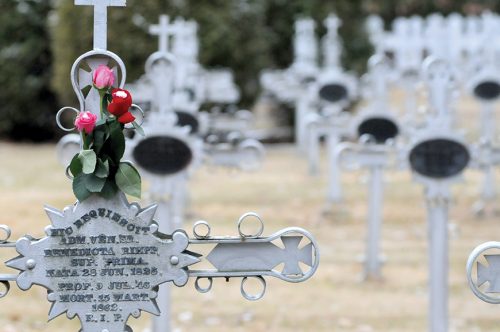“He was crucified, died, and was buried.”
These familiar words from the Creed reflect each Gospel’s Passion narrative, underscoring the historical reality and apparent finality of the death of Jesus. First-century beliefs and burial practices are far removed from 21st-century culture and custom in many ways, but we still share the universality of death and need to manage the aftermath of human dying.

At first glance, it may seem that the Church’s preference for the interment of the bodies of those who have died is rooted in the actual burial of Jesus. St. Paul writes: “We were indeed buried with him through baptism into death, so that, just as Christ was raised from the dead by the glory of the Father, we too might live in newness of life” (Romans 6:4). By imitating the way Jesus himself was buried, we are concretely united with the Paschal Mystery, and the connection with an intact bodily resurrection is also evident.
But something deeper is involved than simply conforming to a post-death procedure. After all, bodies are sometimes lost to recovery or so severely disfigured by accident, trauma or disease, that burial is not possible; yet, this does not affect the Church’s faith in the integrity of risen life.
Rather, the Church’s preference for burial enshrines a rich understanding of the human person. As Genesis 1:26-27 reveals, we are made in the image of God, formed from the dust (mud or slime) of the earth (“adám” in Hebrew) and gifted with the breath of life from God. Later theology would expand the terminology of body and soul, but the insight is the same: The human person stands on the threshold of the material and spiritual orders, a unique creation that is a body-soul unity.
In this vision of the human person, the body is not a thing we have, an object that is merely an instrument for our spirits. The body is an essential constituent of who we are. All of this is probed masterfully by St. John Paul II in his “Theology of the Body.” It is in and through the body that we are baptized and made “temples of the Holy Spirit” (1 Corinthians 6:19); all the sacraments reach the person precisely through the body.
In contrast to cultures around them, Christians found in bodily burial an affirmation of the goodness of the body and the hope of its resurrection, enacting their faith in the later phrase of the Creed, belief “in the resurrection of the body.” Burial is counted among the corporal works of mercy. Indeed, along with churches, chapels, oratories and other places of divine worship, cemeteries are considered sacred places in canon law.
Further, cemeteries become places of cherished memories and connections with our loved ones, inspiring hope in eventual reunion. They remind all to remember and pray for those other members of the one Body of Christ who have died before us, and foster veneration for the saints who already share in eternal life. They also reflect the belief that, as one human family, the death of others is not a merely routine or private matter, but our common destiny and, in Christ, linked to our common hope.

Christian burial was a contrast not so much with cremation, the burning of bodily remains, but with underlying ideas that often were reflected in cremation. The first idea would hold that death was the complete and final annihilation of the person, and cremation vividly symbolized that elimination of a personal history, literally going up in smoke and reduced to ashes.
The second idea would hold that only the human soul was of value and, once it was no longer in the body, the body is mere residue with no significance. Followers of the Greek philosopher Plato perhaps reflect this negativity about the body in the phrase “soma sema” — the body is a tomb or a prison of the soul, and death liberates the person from the material world.
Four years ago, the Congregation for the Doctrine of the Faith issued a brief instruction “Ad Resurgendum cum Christo” (“To rise with Christ”) on burial and cremation. Tellingly, it was published on Aug. 15, 2016, the feast of the Assumption of Mary, body and soul, to heavenly glory. The instruction outlines both the theological convictions suggested above and gives specific guidance for the faithful on appropriate reverence for the bodies of the deceased.
To be clear, the Church does not oppose cremation in itself. In a sense, cremation simply hastens the natural process of bodily decay when no longer united to the soul, the principle of the body’s life. However, cremation must not be chosen for reasons that would deny Christian faith in the goodness of the body or in resurrection, or out of hatred for Catholic religion and practice.
More common today, perhaps, is not intentional rejection of Catholic teaching on the body, but as indifference or lack of knowledge of that teaching in a secularized worldview. Whatever their motivation, Catholic faith rejects practices that would deny the intrinsic dignity of the body. Such practices include scattering cremated remains on the land or water; retaining the remains at home rather than burying or entombing them; dividing the remains and using them in the creation of jewelry, paintings, sculpture, tattoos or other artifacts.
The inherent goodness and sublime dignity of the body is demonstrated in the Incarnation we celebrate at Christmas (that the Word took flesh) and the Resurrection we rejoice in at Easter. The bodily resurrection of Jesus radiantly reveals that the human body is destined for eternal life and thus merits respect and reverence; for “both in life and death, we are the Lord’s” (Romans 14:8).
Father Tom Knoblach is pastor of Sacred Heart in Sauk Rapids and Annunciation in Mayhew Lake. He also serves as consultant for health care ethics for the Diocese of St. Cloud.





















